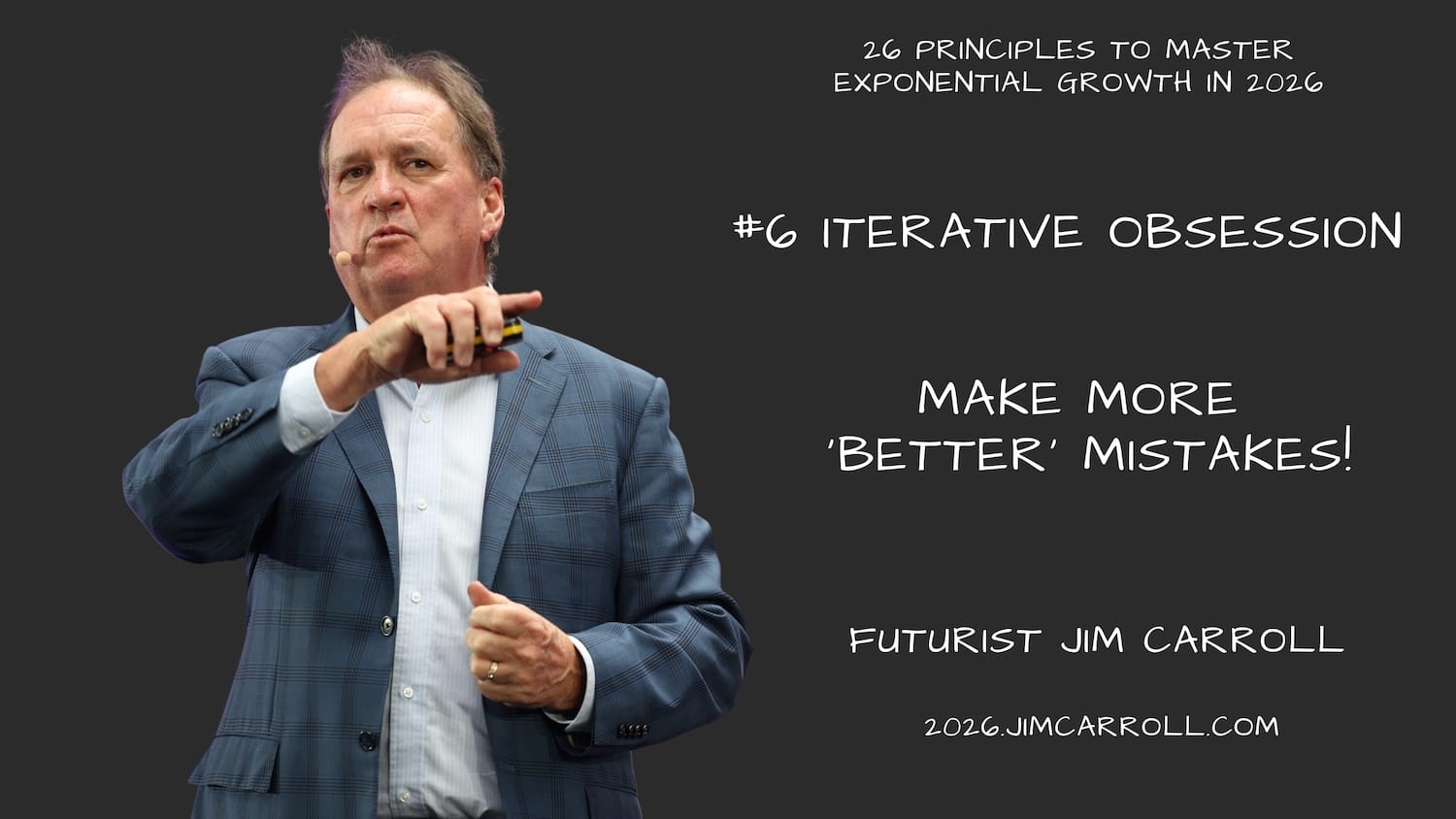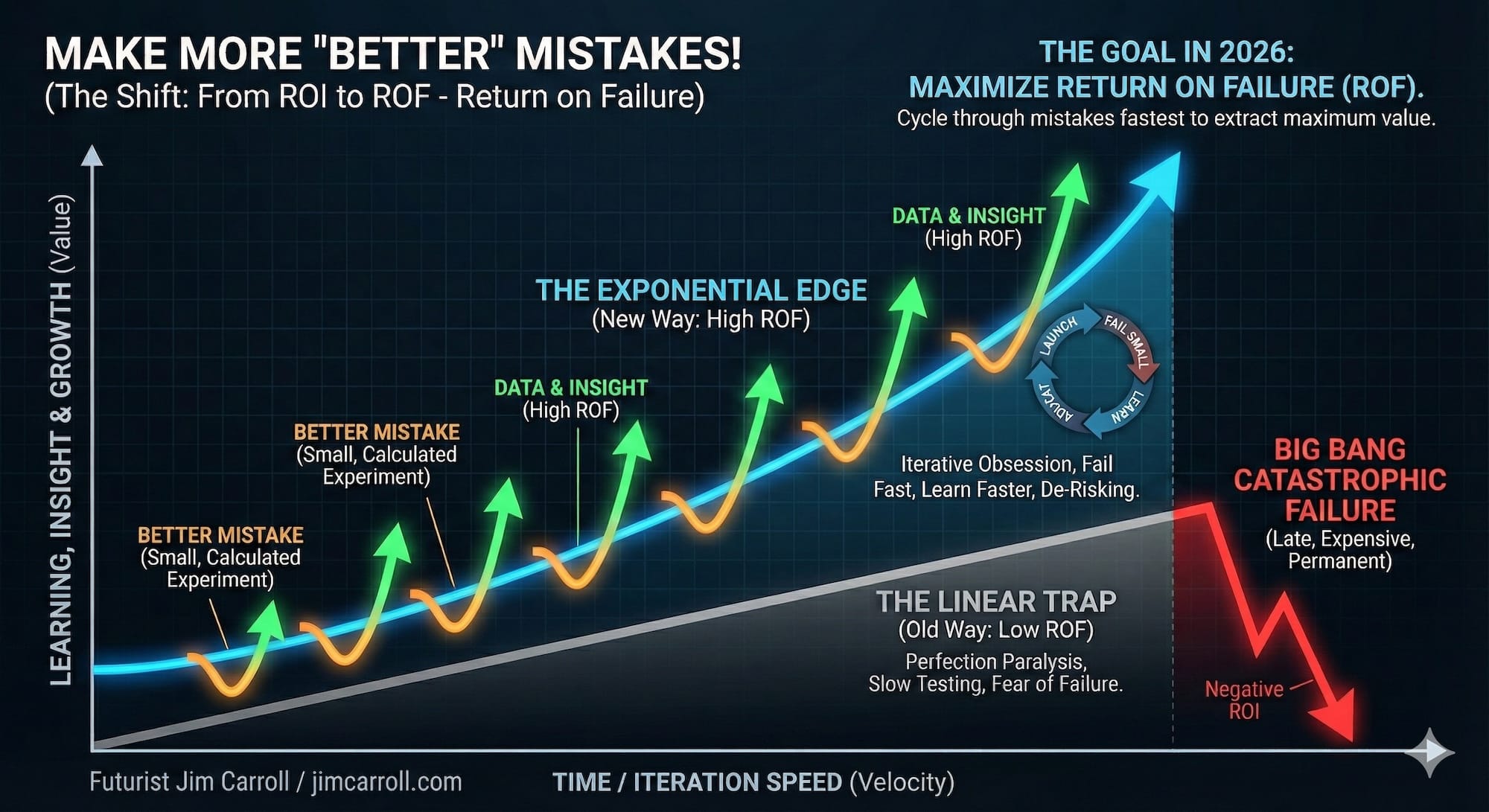"Make more 'better' mistakes!" - Futurist Jim Carroll

In 2026, your new ROI should be ROF - "Return on Failure"
We are on Day 6. We've reset your clock, cleared the path, built your courage, turned on your radar, and accelerated your learning.
Now, we need to completely rewire your relationship with failure.
Why? Because, as the saying goes, in a fast world, innovators fail faster!
Think about it. In a linear, slow-paced world, mistakes were expensive, permanent, and career-limiting. You spent years perfecting a product or strategy behind closed doors to ensure a flawless "Big Bang" launch. The ultimate metric was ROI—Return on Investment—and "failure" meant negative ROI.
Those days are gone. In an exponential world, that math is backwards. The new reality is that not making mistakes fast enough is the biggest mistake of all.
If you aren't making mistakes, you aren't moving fast enough. You aren't testing the boundaries. You are operating on old assumptions while the world shifts beneath your feet.
In that context, your goal isn't to avoid failure; it's to maximize what you learn from it to do it better the next time, right away. Every failure gives you invaluable data, insight, and lessons about speed. You need to make more mistakes, make them faster, and make them better, meaning they are small, calculated experiments designed to yield maximum learning, not sloppy errors born of carelessness.
It's all about this:

In other words, make more better mistakes!
Here's your chalkboard summary!

What I've covered
I've been speaking and writing about this new iterative world for years. Digging into some of my topics, here's what I've covered.
- automotive industry.
The old way: A car company avoids mistakes by spending five years designing a new model, building expensive physical prototypes, and testing them slowly on a track. The cost of a late-stage failure is catastrophic. Edsel, anyone?
The new way: An AI-driven manufacturer embraces virtually "breaking" things. They use "digital twins" to simulate thousands of design failures virtually before cutting a single piece of metal, massively accelerating the R&D cycle. Product designers use generative AI to generate hundreds of "wrong" concepts in minutes, rapidly filtering through failures to find the breakthrough idea.
- using AI for rapid idea prototyping
The old way: slow, methodical, committee or collaborative design processes involving graphic design, product architecture managers, and copywriters. As the idea is developed, it is tested, refined, perfected, over a period of weeks, months, years....and the product is already obsolete by the time it gets to market.
The new way: Already, product designers are using AI image generators to create hundreds of variations of a product concept in minutes, allowing them to iterate on aesthetics and function at a speed previously impossible. Multiple variations of the product are brought to market as real-time customer feedback floods in.
- predictive maintenance
The old way: a product breaks down. The customer brings it in. It's fixed. Time is wasted. The key problem is that the system isn't designed to provide any feedback up the chain that might help other customers solve the same problem.
The new way: A product is engineered to provide instant, up-to-date data on its operating condition. An AI "learns" from every machine failure, iteratively improving its predictive model across the entire fleet. We now know what is likely to break down and when, so we can alert the customer in advance. This fundamentally changes the nature and value of the product. Crazy idea? It's already a reality in the automotive and aerospace sectors, where data from a single component failure is used to instantaneously update the maintenance schedules and design parameters for thousands of other units globally.
- the "iterative supply chain"
The old way: Supply chains are designed to be rigid, planned systems to fluid, iterative networks that can't react in real-time to disruptions. Tariffs and volatility happen. Oops!
The new way: AI algorithms iterate through thousands of potential shipping routes and supplier options every minute based on real-time data like weather, tariffs, and port congestion, constantly re-optimising the flow of goods. The company moves from just-in-time to just-in-case!
- "iterative personalization" in the consumer goods industry
The old way: Mass production. Our assembly line builds hundreds, thousands, and millions of products that are all the same. Consumers become bored with the brand, tired of the product, wary of the investment.
The new way: Mass customization. Sophisticated analysis, 3d printing, rapid assembly line agility- we have now created products-of-one. We're exploring doing this with personalized nutrition and skincare, where an AI analyses user data (e.g., biomarkers, feedback) and iteratively adjusts the product formulation for the next delivery, creating a continuously improving, personalized product loop.
Here's the key thing about all these disruptive examples: the fundamental change, like how things are 'done', provides an opportunity to learn from the mistakes that might have been made. This allows for changes, adjustments, improvements, and a new form of iterative development of the nature of the product or service. It shifts the entire business model from a Low ROF ("Return on Failure" to a High ROF. And that's a fundamental and massive change!
In that context, as we continue to go into this new world in 2026, the lesson is becoming clear - the market belongs to those who can cycle through their mistakes the fastest and extract the most value from them.
In that context, the discipline you must master is Iterative Obsession - challenging yourself to pursue new methodologies in the same way as outlined above to learn from and improve upon, from your mistakes.
And one important thing to realize - this iterative idea doesn't just apply to products and services - it applies to your skills. The old way had you learning new knowledge and learning how to apply it. The new way? It has you learning new knowledge - applying it - learning what worked and what didn't work - and going and getting new knowledge at a faster speed, to accelerate your skills faster. If you comprehend that, you comprehend the inherent value of an iterative obsession.
1. The Exponential Mindset
Iterative Obsession?
It's the shift from a "launch and move on" mentality to a "test and learn" mentality.
It's a bias for action where you prioritize the speed of the learning loop over initial perfection. You view your first attempt not as a final product to be judged, but as a hypothesis to be tested—a deliberate attempt to generate data, often through failure.
Silicon Valley has been doing this for years. Heck, my Tesla Model 3 is an iterative car - shipped with an original set of features, it keeps on getting software updates that improve upon things, add new features, and correct previous flaws.I wrote about this extensively, exploring the idea of iterative software platforms in my post, 11 Rules of IOT Architecture. Read it and learn from it.
Bottom line? A relentless commitment to the cycle of Launch -> Fail -> Learn -> Adjust -> Repeat, executed at high velocity to maximize your ROF!
2. The Linear Trap
Are you stuck in a non-iterative world with what you do?
Ask yourself if you are stuck in these common traps. They are the anchors keeping your execution linear while the market demands exponential speed.
- Perfection paralysis: You keep delaying action until you have 100% certainty or a flawless product. You are terrified of the "mistake" of releasing something imperfect, not realizing that in an exponential world, "perfect and late" is the ultimate failure.
- A "Big Bang" launch mentality: You are trapped in a world and mindset that has you believing that success comes from a single, massive, perfectly executed event. You spend all your resources on one giant bet, leaving no room for the necessary small mistakes and adaptations that actually lead to success.
- Fear of public failure: You hide your work until it is "ready" because you are afraid of criticism. You forget that market feedback on an imperfect product is the most valuable data you can get!
- Treating failure as a verdict, not data: When something goes wrong, you view it as a personal or professional indictment, rather than an objective data point that tells you what to do next.
Overall, you view failure as an enemy to be feared, not an ally you need to align with!
3. The Exponential Edge
Exponential thinkers flip this idea - failure is your best friend!
When you master Iterative Obsession and start maximizing your Return on Failure, you transform your relationship with execution:
- Speed to Insight: In this new model, you now get real-world data faster than your competitors. While they are still arguing in a conference room about what might work, you have already run three failed experiments and found the one thing that does work - and have modified your product or service accordingly. Customers are, like, 'Wow! These guys rock!' because they keep getting new versions of what they bought.
- De-Risking the Future: By launching small, iterative experiments (making small mistakes early), you avoid the catastrophic risk of the massive "Big Bang" failure later. You fail small, learn fast, and pivot cheap.
- Continuous Improvement Engine: You create a culture where improvement is constant because testing is constant. Your product, strategy, or career is never "done"; it is always in a state of becoming better through iteration.
Welcome to 2026 - a world of constant improvement at speed!
Let's bounce this back to the skills issue. Right now, I'm working at a furious pace to learn as much as I can about all the different aspects of AI, so I can determine what it means for my skill base. Last night, l I spent some leisure time by developing a new weather model. I have an AI that is going off and grabbing detailed weather insight from an online database for predictions 14 days out. I'm using what's called API's - application programming interfaces - to grab the data from a weather service.
The data I get back looks like this:

I then feed it to Google Gemini (my current AI of choice) via an API and "Python" code, to have it develop a detailed narrative weather forecast for two weeks out - as well as a cool little image that summarizes the text.

Why am I doing this? Well, I ski, and I'm interested in knowing when the season might start. Not only that, but I'm learning - and my constant mistakes as I use AI to learn how to program this type of routine have me learning more about how to program as well as more about how sophisticated AI applications are built.
And I'm getting a very high ROF! Right now, the final part is failing every step of the way, but later today, I'll get it working - and my constant iterative process not only has me learning fast, but allows me to transition my knowledge base into the invaluable benefits of constant failure!
4. The Immediate Pivot
Here's the thing: you cannot simply become iterative by planning to be iterative.
You must start making better mistakes to boost your "return on failure" (ROF). Here are a few immediate actions to increase your mistake velocity:
- Identify a "Minimum Viable Test" (MVT): Take a project you've been planning. What is the smallest, fastest thing you can launch this week to test your biggest assumption? Do it, expecting it might fail, and define what data you want to capture.
- Learn to conduct "Failure Post-Mortem": Take a recent failure or setback. Instead of burying it, spend 30 minutes analyzing it with your team. What was the hypothesis? Why was it wrong? How will that data change your next iteration? This is how you calculate your ROF.
- Kill your zombies: Find a detailed, long-term project plan that is more than three months old. Tear it up. Replace it with a 30-day sprint plan focused on running a series of rapid experiments.
- Shift your language: In your next meeting, replace the phrase "Is this ready?" with "What is the fastest way we can test the idea?" Shift the focus from perfection to experimentation.
- Adopt the "two-week rule": For any new initiative, commit to putting something tangible—a prototype, a pilot, a draft—in front of real users within two weeks to start gathering feedback data.
In 2026, the greatest risk isn't failure; it's stagnation.
The exponential world won't wait for your perfect plan. To thrive, you must trade the safety of slow and methodical - and perfect - for the velocity of iterative thinking. You need to embrace the cycle of rapid testing, honest failure, and quick adaptation as your new operating system.
Always think about this - what you really want to do is maximize your Return on Failure (ROF) as your new success metric! You don't just de-risk your future—you accelerate it, ensuring that your skills, products, and strategies evolve at the speed of the market itself.
Futurist Jim Carroll can count the mistakes he's made on many hands.

